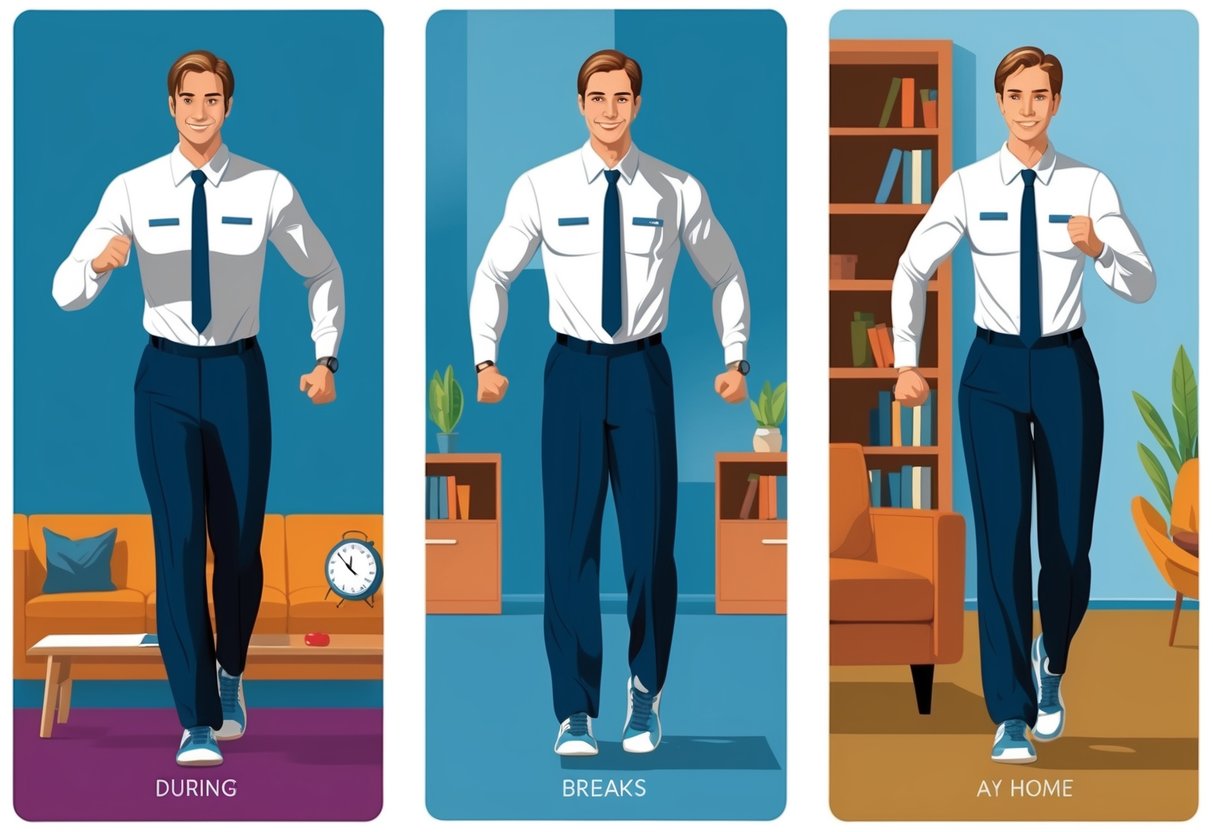Shift work presents unique challenges for maintaining a healthy lifestyle. But with the right approach, you can still achieve your fitness goals.
Balancing exercise with irregular schedules requires creativity and commitment. The key to successful fitness as a shift worker is adapting your workout routine to fit your specific work pattern and energy levels.
Finding time for exercise amidst rotating shifts may seem daunting, but it’s crucial for your physical and mental well-being. By prioritizing physical activity, you can improve sleep quality, manage stress, and boost energy levels.
This guide will provide practical strategies to help you incorporate exercise into your busy and often unpredictable life as a shift worker.
Popular Posts
- Massage Gun vs. Foam Roller: Which Recovery Tool Reigns Supreme?
- 27 Best Calisthenics Exercises for Full-Body Strength and Fitness
- 10 HIIT Workouts for Busy Professionals: Max Fitness, Min Time
- Good Posture Working from Home: Optimize Your Workspace to Prevent Discomfort and Health Issues
- The Best Crossfit Exercises for Full-Body Conditioning
Whether you’re a nurse, firefighter, or work in any other profession that demands irregular hours, this article will offer tailored advice to help you stay active and healthy.
You’ll learn how to create a flexible workout plan, maximize your available time, and choose exercises that complement your work schedule.
Key Takeaways
- Adapt your workout routine to your shifting schedule and energy levels
- Prioritize exercise to improve sleep, manage stress, and boost energy
- Create a flexible fitness plan that fits your unique work-life balance
Understanding the Shift Worker’s Lifestyle

Shift work presents unique challenges for maintaining a healthy lifestyle. It affects sleep patterns, eating habits, and exercise routines, requiring adaptability and careful planning.
Defining Shift Work and Its Variations
Shift work encompasses various schedules outside the typical 9-to-5 workday. It includes night shifts, rotating shifts, and split shifts.
Night shifts run from evening to early morning, often 11 PM to 7 AM. Rotating shifts change weekly or monthly, alternating between day, evening, and night. Split shifts involve two or more work periods within 24 hours.
Some industries heavily rely on shift work:
- Healthcare
- Manufacturing
- Transportation
- Emergency services
- Hospitality
These irregular schedules can disrupt your body’s natural circadian rhythm, leading to various health issues.
Health Challenges for Shift Workers
Shift work can take a toll on your physical and mental well-being. Sleep deprivation is a common problem, as your body struggles to adjust to changing sleep patterns. This can lead to fatigue, reduced alertness, and increased risk of accidents.
Other health challenges include:
- Digestive issues
- Weight gain and obesity
- Cardiovascular problems
- Weakened immune system
- Increased stress levels
- Higher risk of depression and anxiety
Social isolation is another concern, as your work hours may conflict with family and social activities. This can contribute to feelings of loneliness and impact your mental health.
The Impact of Irregular Schedules on Exercise
Maintaining a consistent exercise routine can be challenging with irregular work hours. Your energy levels may fluctuate, making it difficult to find motivation. Time constraints and fatigue can lead to skipped workouts.
Exercising at odd hours may affect your sleep quality. Working out too close to bedtime can increase alertness, making it harder to fall asleep. However, regular physical activity can improve your overall sleep quality and help regulate your body’s internal clock.
Finding a balance is key. You might need to adjust your workout timing and intensity based on your shift schedule. Short, frequent exercise sessions throughout the day can be more manageable than long workouts.
Maximizing Sleep Quality and Circadian Rhythm Management

Shift workers face unique challenges in maintaining healthy sleep patterns. Effective strategies can help align your exercise routine with your sleep schedule and improve overall sleep quality.
Strategies for Improved Sleep Hygiene
Create a dark, quiet, and cool sleeping environment. Use blackout curtains or an eye mask to block out light. White noise machines can help mask disruptive sounds.
Establish a consistent pre-sleep routine. This might include relaxation techniques like deep breathing or gentle stretching. Avoid screens for at least an hour before bed, as blue light can interfere with melatonin production.
Limit caffeine and alcohol intake, especially close to bedtime. Both can disrupt sleep quality and make it harder to fall asleep.
Consider using a sleep tracking app to monitor your sleep patterns. This data can help you identify areas for improvement and track progress over time.
Aligning Exercise with Your Sleep Schedule
Time your workouts strategically. If you work night shifts, exercise before your shift to boost energy and alertness. For day shifts, morning exercise can help reset your body clock.
Outdoor exercise in natural light can help regulate your circadian rhythm. Even a short walk during daylight hours can be beneficial.
Avoid intense exercise too close to bedtime, as it may interfere with sleep. Aim to finish vigorous workouts at least 3 hours before you plan to sleep.
Incorporate stress-reducing activities like yoga or tai chi into your routine. These can help manage shift work-related stress and improve sleep quality.
Listen to your body and adjust your exercise timing as needed. Your optimal workout schedule may change as you adapt to different shift patterns.
Designing an Effective Workout Routine for Shift Workers
Crafting a fitness plan that accommodates irregular work hours requires strategy and flexibility. You’ll need to identify optimal exercise times, create adaptable routines, and balance different types of physical activity.
Identifying the Best Times to Exercise
Consider your shift patterns when scheduling workouts. If you work nights, try exercising before your shift to boost energy and alertness. For day shifts, a post-work workout can help you unwind. On days off, aim for times when you feel most energetic.
Listen to your body’s natural rhythms. Some people prefer morning workouts, while others feel stronger in the afternoon. Experiment to find what works best for you.
Keep workout gear readily available. This allows you to take advantage of unexpected free time for a quick session.
Creating a Flexible Fitness Routine
Develop a mix of shorter and longer workouts to fit various time slots. Include 10-15 minute routines for busy days and more comprehensive 45-60 minute sessions when time permits.
Use bodyweight exercises that can be done anywhere, such as push-ups, squats, and lunges. These require no equipment and can be performed in limited spaces.
Incorporate high-intensity interval training (HIIT) for efficient, time-saving workouts. HIIT alternates short bursts of intense activity with brief rest periods.
Consider split routines, focusing on different muscle groups each day. This approach allows for shorter, more frequent workouts.
Including Strength Training and Cardio
Balance your routine with both strength training and cardiovascular exercise. Aim for at least two strength sessions per week, targeting major muscle groups.
Use resistance bands or dumbbells for portable strength training options. These versatile tools allow you to work out at home or during breaks at work.
For cardio, mix in activities like brisk walking, jogging, cycling, or swimming. Choose exercises you enjoy to increase consistency.
Try circuit training to combine strength and cardio in one efficient workout. This method involves moving quickly between different exercises with minimal rest.
Nutrition and Meal Planning for Energy and Fitness
Proper nutrition and strategic meal planning are crucial for shift workers to maintain energy levels and support fitness goals. Focusing on balanced nutrients, smart meal timing, and convenient preparation can help you stay fueled and perform at your best.
Balancing Nutrients and Meal Timing
Aim for a mix of complex carbohydrates, lean proteins, and healthy fats in your meals. Complex carbs provide sustained energy, while proteins support muscle repair and recovery. Healthy fats help with nutrient absorption and hormone balance.
Time your meals around your work schedule. Eat a balanced meal 2-3 hours before your shift starts. During your shift, have smaller, frequent meals or snacks every 3-4 hours to maintain steady blood sugar levels.
For night shifts, consider having your “breakfast” when you wake up and your “dinner” midway through your shift. This helps align your eating patterns with your body’s circadian rhythms.
Meal Prep Tips for Busy Shift Schedules
Batch cook on your days off to save time during the workweek. Prepare large quantities of versatile ingredients like grilled chicken, roasted vegetables, and cooked grains. Store them in portioned containers for quick assembly.
Invest in quality food storage containers and a good insulated lunch bag. This allows you to pack multiple meals and snacks for longer shifts.
Use a slow cooker or instant pot to prepare meals while you sleep or work. These appliances can have a hot, nutritious meal ready when you return home.
Prep grab-and-go items like overnight oats, pre-cut fruit, or homemade energy bars for easy access during busy times.
Healthy Snacks for Energy Maintenance
Keep nutrient-dense snacks on hand to combat fatigue and maintain energy levels throughout your shift. Some options include:
- Greek yogurt with berries and nuts
- Hard-boiled eggs and whole-grain crackers
- Apple slices with almond butter
- Hummus with vegetable sticks
- Trail mix with dried fruit and seeds
- Whole grain wrap with turkey and avocado
Stay hydrated by keeping a water bottle nearby. Limit caffeine intake, especially in the latter part of your shift, to avoid disrupting your sleep when you get home.
Choose snacks that combine protein and complex carbs for sustained energy. Avoid sugary snacks that can lead to energy crashes.
Building Healthy Habits Around Shift Work
Establishing a consistent fitness routine as a shift worker requires strategic planning and adaptability.
By integrating exercise into your daily life, setting achievable goals, and staying motivated, you can maintain a healthy lifestyle despite irregular schedules.
Incorporating Physical Activity into Daily Life
Start by identifying pockets of time in your schedule for exercise.
Use your commute as an opportunity to walk or bike when possible.
Take short breaks during shifts to stretch or do quick bodyweight exercises.
Opt for stairs instead of elevators and park farther away to increase your daily steps.
Create a home workout space with minimal equipment like resistance bands or dumbbells.
This allows you to exercise before or after shifts without the need to travel to a gym.
Utilize fitness apps or online videos for guided workouts that fit your available time slots.
Consider active hobbies that double as exercise, such as gardening, dancing, or recreational sports leagues that accommodate varied schedules.
Adapting to Change and Setting Realistic Fitness Goals
Flexibility is key when setting fitness goals as a shift worker.
Focus on weekly exercise targets rather than daily ones to accommodate changing schedules.
Aim for 150 minutes of moderate-intensity aerobic activity or 75 minutes of vigorous-intensity activity per week.
Set SMART goals: Specific, Measurable, Achievable, Relevant, and Time-bound.
For example: “Complete three 30-minute strength training sessions per week for the next month.”
Track your progress using a fitness journal or app.
This helps you stay accountable and adjust your goals as needed.
Be prepared to modify your routine when shift patterns change, and have backup plans for different scenarios.
Maintaining Motivation and Accountability
Find a workout buddy with a similar schedule to keep each other accountable.
If that’s not possible, join online fitness communities or use social media to connect with others who share your goals.
Reward yourself for meeting milestones.
Create a visual representation of your progress, like a chart or calendar, to stay motivated.
Mix up your routine to prevent boredom.
Try new activities or classes that align with your shift schedule.
Set challenges for yourself, such as training for a virtual race or mastering a new exercise.
Remember your ‘why’ – keep your health reasons for exercising at the forefront of your mind.
Write down your motivations and review them regularly, especially when you feel your commitment wavering.
Overcoming Social and Mental Health Hurdles
Shift work presents unique challenges for maintaining social connections and mental wellbeing.
Prioritizing self-care and finding creative ways to stay connected are crucial for your overall health.
Navigating Social Isolation and Family Commitments
Shift work can disrupt your social life and family time.
Schedule regular catch-ups with friends and family during your off hours.
Use technology to stay connected – video calls or group chats can help bridge the gap when you can’t be there in person.
Plan special activities with loved ones on your days off.
This creates quality time to look forward to and helps maintain strong relationships.
Consider joining clubs or groups that align with your interests and schedule.
Communicate openly with your family about your work hours and needs.
Set clear boundaries and expectations to reduce stress and misunderstandings.
Involve them in planning shared activities to ensure everyone’s needs are met.
Coping with Stress and Preventing Burnout
Shift work can take a toll on your mental health.
Establish a consistent sleep routine, even on days off, to help regulate your body clock.
Create a relaxing pre-sleep ritual to wind down after work.
Practice stress-reduction techniques like deep breathing, meditation, or yoga.
These can be done in short bursts during breaks or before/after shifts.
Regular exercise, even in small amounts, can significantly boost your mood and energy levels.
Prioritize healthy eating habits.
Prepare nutritious meals in advance to avoid relying on unhealthy convenience foods.
Stay hydrated and limit caffeine intake, especially towards the end of your shift.
Set realistic goals and learn to say no to extra commitments.
Take regular breaks during your shift to recharge.
If you’re struggling, don’t hesitate to seek support from a mental health professional or employee assistance program.
Support and Resources to Enhance Fitness Progress
Finding the right support and resources can significantly boost your fitness journey as a shift worker.
Access to flexible facilities and online communities can provide the tools and motivation you need to stay on track.
Finding a 24/7 Gym and Personal Training Options
Look for gyms that operate around the clock to accommodate your unpredictable schedule.
Many 24/7 facilities offer key card access, allowing you to work out whenever it suits you best.
Some gyms provide personal training services tailored to shift workers.
These trainers can design programs that fit your unique schedule and energy patterns.
Consider asking about:
- Flexible membership options
- Off-peak hour discounts
- Virtual personal training sessions
Personal trainers experienced with shift work can offer valuable insights on optimizing your workout performance despite irregular hours.
Utilizing Online Platforms and Communities
Leverage digital resources to support your fitness goals.
Fitness apps and online workout platforms offer on-demand classes and routines you can follow anytime, anywhere.
Many provide customizable programs to match your shift patterns and fitness level.
Join online communities or forums dedicated to shift workers pursuing fitness.
These groups can offer:
- Peer support and motivation
- Tips for managing workouts around shifts
- Accountability partnerships
Virtual fitness challenges can keep you engaged and connected with others, regardless of your work hours.
Look for apps that sync with wearable devices to track your progress and compete with friends.
Restorative Practices to Balance Exercise and Recovery
Shift workers need to find ways to balance physical activity with proper recovery. Restorative practices can help you manage stress, improve sleep quality, and maintain overall well-being.
Integrating Yoga and Mindfulness into Your Routine
Yoga offers numerous benefits for shift workers.
Practice gentle stretches before or after your shift to release tension. Focus on poses that target areas prone to stiffness, like the lower back and shoulders.
Try a 10-15 minute yoga session to improve flexibility and reduce stress.
Incorporate mindfulness techniques like deep breathing or meditation.
These practices can calm your mind and prepare you for rest.
Set aside a quiet space at home for your yoga practice.
Use apps or online videos for guided sessions tailored to your schedule.
Remember, consistency is key – even short daily practices can make a significant difference.
Recognizing the Role of Adequate Rest
Quality sleep is crucial for shift workers.
Create a sleep-friendly environment by using blackout curtains and white noise machines.
Stick to a consistent sleep schedule, even on days off.
Limit caffeine intake, especially in the hours before bedtime.
Consider taking short power naps (15-20 minutes) during breaks to boost alertness without interfering with your main sleep period.
Monitor your sleep patterns using a sleep tracking app or device.
This can help you identify areas for improvement in your rest routine.
If you consistently struggle with sleep, consult a healthcare professional for personalized advice.
Frequently Asked Questions
Shift workers face unique challenges when it comes to exercise and maintaining a healthy lifestyle. These common questions address key concerns and provide practical solutions for staying fit despite irregular schedules.
What are effective workout routines for 12-hour shift schedules?
For 12-hour shifts, focus on shorter, high-intensity workouts.
Try 20-30 minute HIIT sessions or circuit training before or after your shift.
On days off, aim for longer strength training or cardio sessions to balance your routine.
Split your workouts into smaller chunks throughout the day if needed. A 10-minute bodyweight routine in the morning and a 20-minute jog after work can be effective.
What is the best time to exercise for night shift workers to ensure optimal performance?
Exercise 1-2 hours before your night shift starts.
This can boost alertness and energy levels for your work hours.
Alternatively, work out shortly after waking up in the afternoon to kickstart your day.
Avoid intense exercise right before bed, as it may interfere with sleep. Light stretching or yoga can be beneficial for winding down after a night shift.
How can shift workers maintain a healthy lifestyle despite irregular hours?
Plan and prep meals in advance to ensure you have nutritious options available.
Stay hydrated and limit caffeine intake, especially towards the end of your shift.
Prioritize sleep by creating a dark, quiet sleep environment.
Use blackout curtains and white noise machines if needed.
Stick to a consistent sleep schedule, even on days off.
What are the strategies for fitting in workouts when working long and unpredictable hours?
Keep workout gear in your car or locker for impromptu exercise sessions.
Use lunch breaks or downtime for quick workouts like bodyweight exercises or brisk walks.
Embrace flexibility in your routine.
Be prepared to adjust workout times and durations based on your shifting schedule.
Even short bursts of activity throughout the day can be beneficial.
Are there any specific workout programs designed for the unique needs of shift workers?
Some fitness apps offer customizable programs for shift workers.
Look for options that allow you to input your work schedule and provide flexible workout plans.
Consider working with a personal trainer who has experience with shift workers.
They can create a tailored program that fits your specific schedule and goals.
How can someone stay in shape when their job requires them to work the night shift regularly?
Consistency is key. Establish a routine that aligns with your night shift schedule.
Exercise at the same time each day, whether it’s before or after your shift.
Incorporate active breaks during your shift. Take short walks, do stretches, or perform simple exercises to keep your body moving throughout the night.







